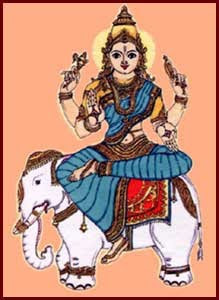The Matrikas assume paramount significance in the goddess-oriented sect of Hinduism, Tantrism. In Shaktism, they are "described as assisting the great Shakta Devi (goddess) in her fight with demons." Some scholars consider them Shaiva goddesses. They are also connected with the worship of warrior god Skanda.
The iconographical features of the Matrikas have been described in Hindu scriptures such as Puranas and Agamas and the epic Mahabharata. Puranas like Varaha Purana, Agni Purana, Matsya Purana, Vishnudharmottara Purana and Devi Mahatmya, a part of Markandeya Purana as well as Agamas such as Amsumadbhedagama, Surabhedagama, Purvakarnagama and Rupamandana describe the Matrikas.
The Ashta-Matrika or Ashta-Matara as described in Devi Mahatmya is given below.
Brahmi (Sanskrit: ब्राह्मि, Brāhmī) or Brahmani (Sanskrit: ब्रह्माणी, Brahmâṇī) is the Shakti (power) of the creator god Brahma. She is depicted yellow in colour and with four heads. She may be depicted with four or six arms. Like Brahma, she holds a rosary or noose and kamandalu (water pot) or lotus stalk or a book or bell and is seated on a Hamsa (identified with a swan or goose) as her vahana (mount or vehicle). She is also shown seated on a lotus with the hamsa on her banner. She wears various ornaments and is distinguished by
her basket-shaped crown called karaṇḍa mukuṭa.
Vaishnavi (Sanskrit: वैष्णवी, Vaiṣṇavī), the power of the preserver-god Vishnu, is described as seated on the Garuda (eagle-man) and having four or six arms. She holds Shankha (conch), chakra (Discus), mace and lotus and bow and sword or her two arms are in varada mudra (Blessing hand gesture) and abhaya mudra ("No-fear" hand gesture). Like Vishnu, she is heavily adorned with ornaments like necklaces, anklets, earrings, bangles etc. and a cylindrical crown called kiriṭa mukuṭa.
Maheshvari (Sanskrit: माहेस्वरी, Māheśvarī) is the power of god Shiva, also known as Maheshvara. Maheshvari is also known by the names Raudri, Rudrani and Maheshi, derived from Shiva's names Rudra and Mahesh. Maheshvari is depicted seated on Nandi (the bull) and has four or six hands. The white complexioned, Trinetra (three eyed) goddess holds a Trishula (trident), Damaru (drum), Akshamala (A garland of beads), Panapatra (drinking vessel) or axe or an antelope or a kapala (skull-bowl) or a serpent and is adorned with serpent bracelets, the crescent moon and the jaṭā mukuṭa (A headdress formed of piled, matted hair).
Aindri, (Sanskrit: ऐन्द्री, Aindrī) also known as Indrani (Sanskrit: इन्द्राणी, Indrāṇī), Mahendri, Shakri and Vajri, is the power of the Indra, the Lord of the heaven. Seated on a charging elephant, Aindri, is depicted dark-skinned, with two or four or six arms. She is depicted as having two or three or like Indra, a thousand eyes. She is armed with the Vajra (thunderbolt), goad, noose and lotus stalk. Adorned with variety of ornaments, she wears the kiriṭa mukuṭa.
Kaumari (Sanskrit: कौमारी, Kaumarī), also known as Kumari, Karttikeyani and Ambika[37] is the power of Kumara (Kartikeya or Skanda), the god of war. Kaumari rides a peacock and has four or twelve arms. She holds a spear, axe, a Shakti (power) or Tanka (silver coins) and bow. She is sometimes depicted six-headed like Kumara and wears the cylindrical crown
Chamunda (Sanskrit: चामुण्डा, Cāṃuṇḍā), also known as Chamundi and Charchika is the power of Devi (Chandi). She is very often identified with Kali and is similar in her appearance and habit.[38] The identification with Kali is explicit in Devi Mahatmya.[39] The black coloured Chamunda is described as wearing a garland of severed heads or skulls (Mundamala) and holding a Damaru, trishula, sword and panapatra. Riding a jackal or standing on a corpse of a man (shava or preta), she is described as having three eyes, a terrifying face and a sunken belly.
Narasimhi (Sanskrit: नारसिंहीं, Nārasiṃhī), power of Narasimha (lion-man form of Vishnu), is a woman-lion and throws the stars into disarray by shaking her lion mane.
Though the first six are unanimously accepted by texts, the name and features of the seventh and eighth Matrika are disputed. In Devi-Mahatmya, Chamunda is omitted after the Saptamatrika list, while in sculpture in shrines or caves and the Mahabharata, Narasimhi is omitted. The Varaha Purana names Yami - the Shakti of Yama, as the seventh and Yogishwari as the eighth Matrika, created by flames emerging from Shiva's mouth. In Nepal, the eighth Matrika is called Maha-Lakshmi or Lakshmi is added omitting Narasimhi. In lists of nine Matrikas, Devi-Purana mentions Gananayika or Vinayaki - the Shakti of Ganesha, characterized by her elephant head and ability to remove obstacles like Ganesha and Mahabharavi omitting Narasimhi.









2 comments:
I'm writing from south america , thanks for the info my name is Maheshwari and gave me as my name's meaning "is one that can control the mind of the driver" and is related to Lord Shiva and is a manifestation of Srimati Radharani.....
very good information, please post strotras/mantras to worship each godess if possible.
Post a Comment